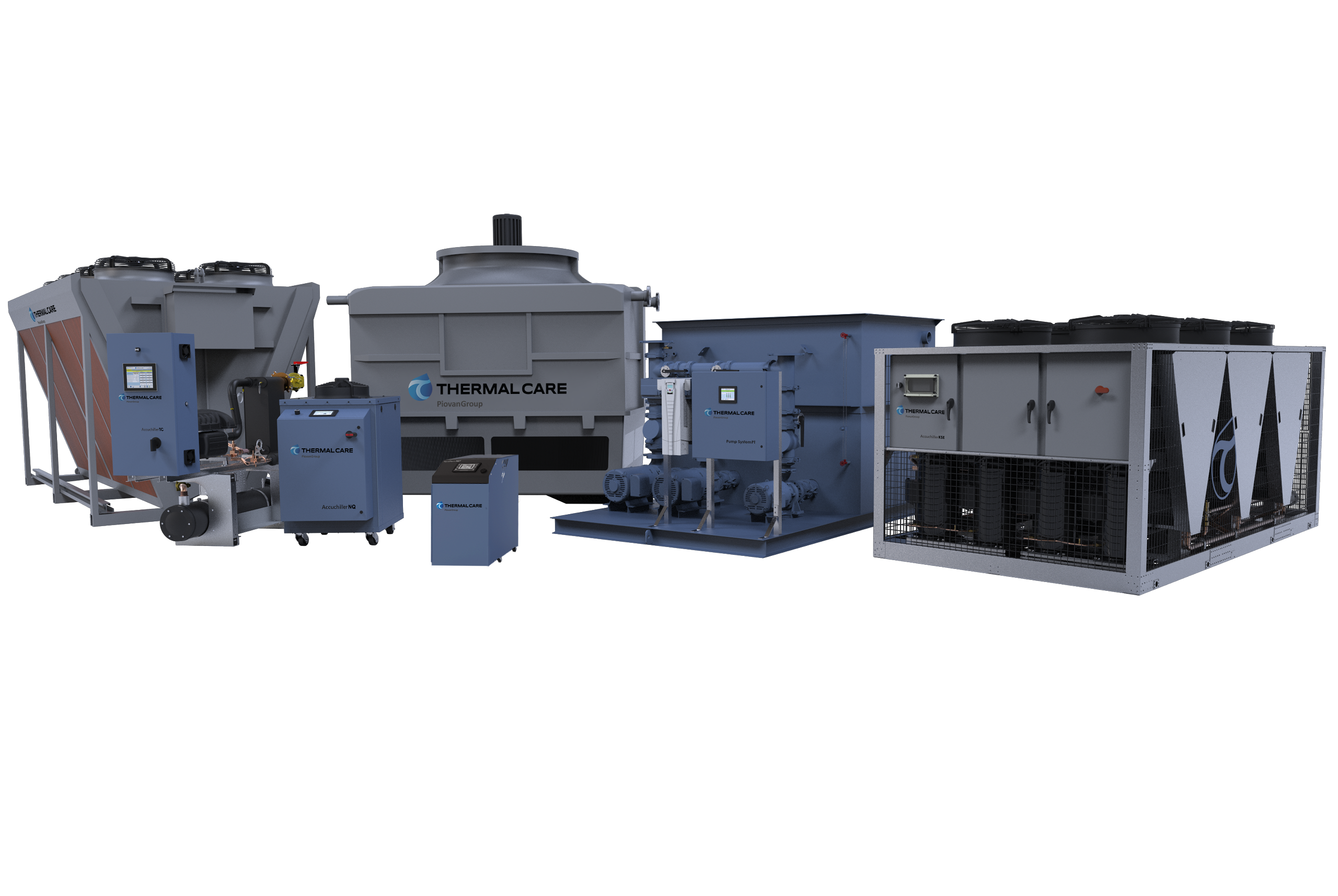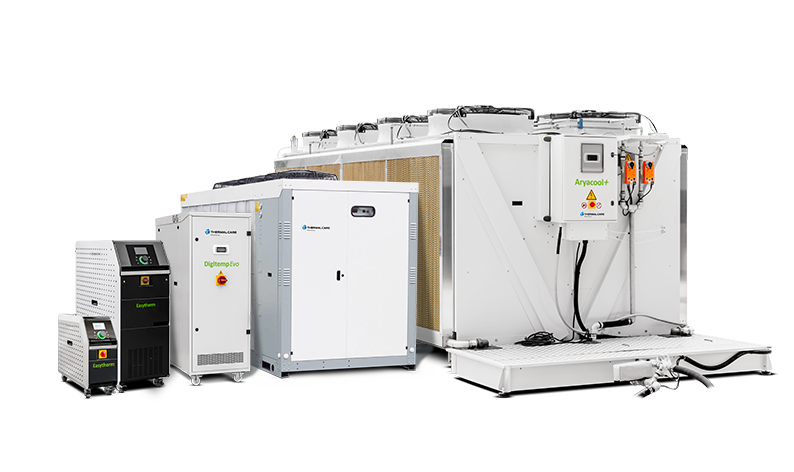Frequently Asked Questions
Thermal Care typically does not rent equipment. Based on your cooling requirement and geographic location, we can provide recommended rental companies that carry Thermal Care equipment. Please use [email protected] to submit request for recommendation.
De-rate capacity by approximately 2% for every degree.
Thermal Care will support you through every step of the process. View our Glycol Chiller Preparation Guide for more information.
Current manuals are located in the Resource Center under manuals https://www.thermalcare.com/service-manuals/
Only current product manuals are shown on the web site. If a unit has been discontinued, contact Customer Service at 847-966-2636 or [email protected] for assistance.
Drawings are shipped with each unit and are generally located in the control cabinet. If unavailable please contact Customer Service at 847-966-2636 or at [email protected]
Thermal Care Sales can direct you to the best person to contact for your project. They can be reached at 847-966-2260 or at [email protected] You can also find information about our sales representatives by clicking here.
The serial number of a unit from 1995 to present uses the last 4 digits to indicate the month and year. If your serial numbers starts with letters please contact Customer Service at 847-966-2636 or at [email protected]
Yes, 3%. We accept Visa, Mastercard, American Express and Discover Card.
UPS
No, Thermal Care has no authorized distributors
Please contact Customer Service at 847-966-2636 or at [email protected]
Warranty information can be found by clicking here.
Warranty information can be found by clicking here.
Inspect the equipment for any visible damage and verify all items shown on the bill of lading are present. If damage is evident, document it on the delivery receipt by clearly marking any item with damage as “unit damage” and notify the carrier. In addition, notify our Customer Service Department at 847-966-2636 and they will provide assistance with preparing and filing freight damage claims, including arranging for an estimate on repair costs; however, filing the shipping damage claim is the responsibility of the receiving party. Do not install damaged equipment without getting the equipment repaired.
Shipping damage is the responsibility of the carrier. To protect against possible loss due to damage incurred during shipping and to expedite payment for damages, it is important to follow proper procedures and keep records. Photographs of damaged equipment are excellent documentation for your records.
The most common and economical method is LTL but partial and dedicated shipments can be arranged.
High refrigerant pressure is an inability to remove heat. Condenser must be cleaned and manual reset must be reset. Refer to the chiller operation and instruction manual for location.
Refrigeration is a thermodynamic cycle. Chillers use refrigeration to extract heat from the process circulation fluid and then ultimately reject it to the atmosphere.
A condenser is s a heat exchanger that transfers heat from the refrigerant gas to an external cooling source (water or air are typical mediums). This transfer causes a phase change from gas to liquid condensation.
Evaporators are heat exchangers that transfer heat from the process fluid into the refrigerant causing a phase change, evaporation.
A BTU (British Thermal Unit) is the most common unit of heat measurement in the United States. It is based upon the amount of energy to heat one pound of water by 1°F. A kcal (kilocalorie) is an International System of units (SI) measurement of heat.
Heat Exchangers are designed to transfer heat from one fluid to another without mixing. The fluids are physically separated by the heat exchanger allowing heat energy to flow between them. The fluids can be a variety of compounds – water, oil, refrigerant, etc.
Remote condenser information is included in the corresponding chiller operation and instruction manual.
Refrigerant charge information for chillers is located in corresponding chiller operation and instruction manual. Please contact Customer Service at 847-966-2636 or at [email protected] for remote units.
Glycol information for chillers is located in the corresponding chiller operation and instruction manual.
The most obvious indication is when the chiller's compressor runs continuously but is unable to achieve the set point.
Ethylene glycol is the less expensive option but it is also toxic. It has lower negative impact on heat transfer as well as pump performance. Propylene glycol can be up to 15% more expensive than ethylene and with its higher viscosity inhibits heat transfer and pump performance more. However, it is non-toxic which over the past 10 years has made it the preferred choice of industrial cooling systems.
A Y strainer, also commonly referred to as a wye-strainer, is a component in process water lines that physically removes solids and other particle contaminants. These are included as standard in Thermal Care chillers to protect the evaporators from potential clogging. View video for information on how to change a Y-strainer.
Many Thermal Care chillers are available with outdoor duty designs. This is standard for some larger units and separated as an option for other chillers. Be sure to consider the installation location to avoid closed off areas that inhibit airflow or create extended periods of direct sun exposure. Also, ambient temperature exposure is important. Very low temperatures can affect a chillers ability to start while high ambient temperature can reduce the chillers available cooling capacity.
The chiller uses its condenser as one of the walls of the enclosure. The air pulled through the chiller by the fan must go over this condenser to remove the heat from the refrigerant. If an access panel is open, the majority of the airflow will circumvent the condenser through the unrestricted panel door opening. Not enough heat will be removed from the refrigerant and the pressure will start to increase eventually reaching critical safety levels causing the unit to shut down. By replacing the access panel while the unit is in operation you can avoid this issue.
This is a method to directly calculate the required cooling for an application. While the process is running, measure the flow rate and temperature rise through the process. Using this info, the real-life cooling requirement is determined. This is a more accurate method than using theoretical calculations based upon assumptions. Thermal Care recommends including a safety factor to ensure enough cooling capacity for worst-case scenarios.
A VFD or variable frequency drive, is an electronic piece of equipment that controls the speed of a motor by adjusting the frequency of the electrical supply. These are often used with pump and fan motors to control the fluid flow rate or air volume flow. A VFD can be manually set to a specific frequency or can accept an external input from a sensor.




